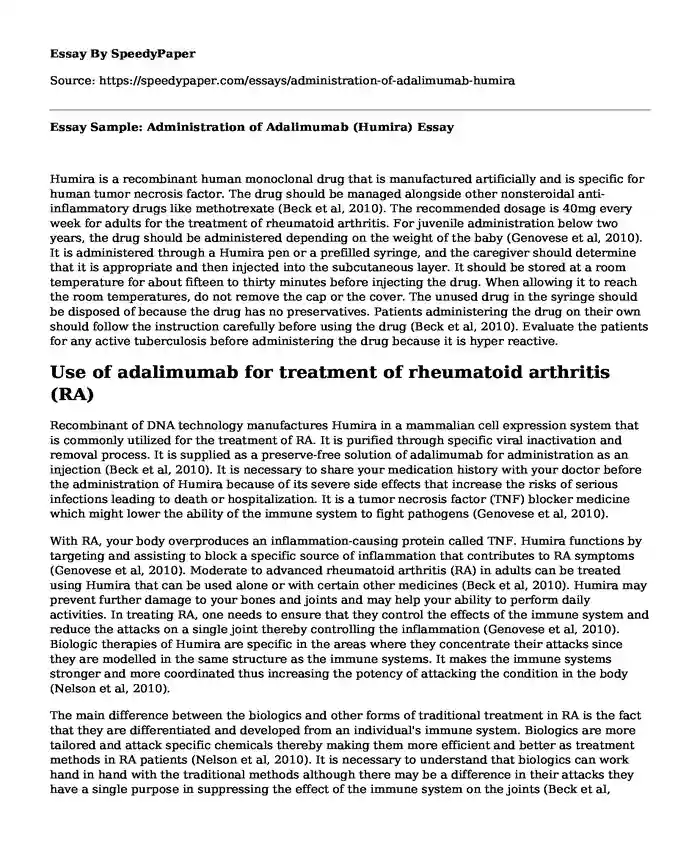
| Type of paper: | Essay |
| Categories: | Health and Social Care Medicine |
| Pages: | 3 |
| Wordcount: | 720 words |
Humira is a recombinant human monoclonal drug that is manufactured artificially and is specific for human tumor necrosis factor. The drug should be managed alongside other nonsteroidal anti-inflammatory drugs like methotrexate (Beck et al, 2010). The recommended dosage is 40mg every week for adults for the treatment of rheumatoid arthritis. For juvenile administration below two years, the drug should be administered depending on the weight of the baby (Genovese et al, 2010). It is administered through a Humira pen or a prefilled syringe, and the caregiver should determine that it is appropriate and then injected into the subcutaneous layer. It should be stored at a room temperature for about fifteen to thirty minutes before injecting the drug. When allowing it to reach the room temperatures, do not remove the cap or the cover. The unused drug in the syringe should be disposed of because the drug has no preservatives. Patients administering the drug on their own should follow the instruction carefully before using the drug (Beck et al, 2010). Evaluate the patients for any active tuberculosis before administering the drug because it is hyper reactive.
Use of adalimumab for treatment of rheumatoid arthritis (RA)
Recombinant of DNA technology manufactures Humira in a mammalian cell expression system that is commonly utilized for the treatment of RA. It is purified through specific viral inactivation and removal process. It is supplied as a preserve-free solution of adalimumab for administration as an injection (Beck et al, 2010). It is necessary to share your medication history with your doctor before the administration of Humira because of its severe side effects that increase the risks of serious infections leading to death or hospitalization. It is a tumor necrosis factor (TNF) blocker medicine which might lower the ability of the immune system to fight pathogens (Genovese et al, 2010).
With RA, your body overproduces an inflammation-causing protein called TNF. Humira functions by targeting and assisting to block a specific source of inflammation that contributes to RA symptoms (Genovese et al, 2010). Moderate to advanced rheumatoid arthritis (RA) in adults can be treated using Humira that can be used alone or with certain other medicines (Beck et al, 2010). Humira may prevent further damage to your bones and joints and may help your ability to perform daily activities. In treating RA, one needs to ensure that they control the effects of the immune system and reduce the attacks on a single joint thereby controlling the inflammation (Genovese et al, 2010). Biologic therapies of Humira are specific in the areas where they concentrate their attacks since they are modelled in the same structure as the immune systems. It makes the immune systems stronger and more coordinated thus increasing the potency of attacking the condition in the body (Nelson et al, 2010).
The main difference between the biologics and other forms of traditional treatment in RA is the fact that they are differentiated and developed from an individual's immune system. Biologics are more tailored and attack specific chemicals thereby making them more efficient and better as treatment methods in RA patients (Nelson et al, 2010). It is necessary to understand that biologics can work hand in hand with the traditional methods although there may be a difference in their attacks they have a single purpose in suppressing the effect of the immune system on the joints (Beck et al, 2010). Adalimumab is a better treatment option in treating RA among patients in the present society, but that they do not work for everyone. Some people have to stop using the drugs due to the side effects while others have to stop because they experience no benefits (Genovese et al, 2010). As with the traditional methods of treating RA, doctors have to be hopeful of the drugs and hope that patients will have positive effects on the treatment methods highlighted.
References
Beck, A., Wurch, T., Bailly, C., & Corvaia, N. (2010). Strategies and challenges for the next generation of therapeutic antibodies. Nature Reviews Immunology, 10(5), 345-352.
Genovese, M. C., Van den Bosch, F., Roberson, S. A., Bojin, S., Biagini, I. M., Ryan, P., & SloanLancaster, J. (2010). LY2439821, a humanized antiinterleukin17 monoclonal antibody, in the treatment of patients with rheumatoid arthritis: A phase I randomized, doubleblind, placebocontrolled, proofofconcept study. Arthritis & Rheumatism, 62(4), 929-939.
Nelson, A. L., Dhimolea, E., & Reichert, J. M. (2010). Development trends for human monoclonal antibody therapeutics. Nature reviews Drug discovery, 9(10), 767-774.
Cite this page
Essay Sample: Administration of Adalimumab (Humira). (2019, Sep 23). Retrieved from https://speedypaper.com/essays/administration-of-adalimumab-humira
Request Removal
If you are the original author of this essay and no longer wish to have it published on the SpeedyPaper website, please click below to request its removal:
- Education Essay Sample: Academic Problems People Have Overcome
- Essay Sample on the Factors That Foster Success in Teams
- Essay Sample: The Struggle for Democratic Stability in North Carolina and South Carolina
- Generalized Anxiety Disorder: The Case of Alice, Free Essay
- Free Essay about Kingdom Hall Believers
- Paper Example: Strategic Evaluation
- Free Essay Sample. Description of Europe
Popular categories




